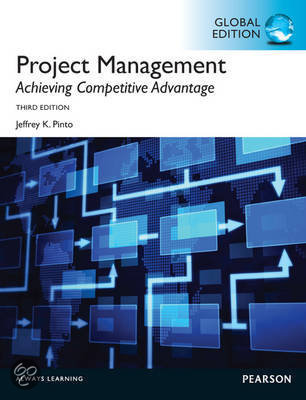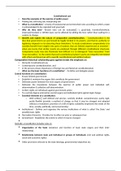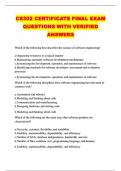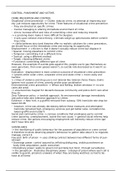Project Management Summary
A process refers to ongoing, day-to-day activities in which an organization engages while
producing goods or services. Processes use existing systems in a continuous, fairly
repetitive manner. “repetitive tasks”
Projects take place outside the normal, process-oriented world of the firm.
Process Project
Repeat process or product New process or product
Several objectives One objective
Ongoing One shot limited life
People are homogenous More heterogeneous
Well-established systems Integrated system efforts
Greater certainty (cost, schedule etc.) Greater uncertainty
Part of line organization Outside of line organization
Established practices Violates established practice
Supports status quo Upsets status quo
Three Definitions of Projects
1. A project is a unique venture with a beginning and end, conducted by people to
meet established goals within parameters of cost, schedule, and quality.
2. Projects are goal-oriented, involve the coordinated undertaking of interrelated
activities, are of finite duration, and are all, to a degree, unique.
3. A project = organized work toward a predefined goal / objective that requires
resources & effort, a unique and so risky) venture having a budget and schedule.
A project can be considered to be any series of activities and tasks that:
1. Have a specific objective to be completed within certain specifications
2. Have defined start and end dates
3. Have funding limits (if applicable)
4. Consume human and nonhuman resources (i.e., money, people, equipment)
5. Are multifunctional (i.e., cut across several functional lines)
What is a Project?
• Projects are complex, one-time processes à for a specific goal
• Projects are limited by budget, schedule, and resources à they are a “resource
constrained activity”
• Projects are developed to resolve a clear goal or set of goals
• Projects are customer-focused à must meet customer needs
A project is a temporary endeavor (no perpuity) undertaken to create a unique product,
service or result. Projects are discrete activities.
,General Project Characteristics
• Projects are ad hoc endeavors with a clear life cycle à initiated as needed, and
then disbanded. They are temporary operations.
• Projects are building blocks in the design and execution of organizational
strategies. à projects lead to design of strategies.
• Projects are responsible for the newest and most improved products, services, and
organizational processes. à Projects = innovation
• Projects provide a philosophy and strategy for the management of change.
• Project management entails crossing functional and organizational boundaries. à
projects bring together people from various functions across the company.
• Traditional management functions of planning, organizing, motivation, directing,
and controlling apply to project management.
• Principal outcomes of a project are the satisfaction of customer requirements
within the constraints of technical, cost, and schedule objectives.
• Projects are terminated upon successful completion of performance objectives.
Project Success Rates
• Software and hardware projects fail at a 65% rate.
• Over half of all IT projects become runaways.
• Only 30% of technology-based projects and programs are a success.
Although project management is becoming popular, it is not easy to assimilate into the
conventional (old) processes of most firms. We should also not overestimate the benefits
to be gained from project management while underestimating the commitment required
to make a project work.
Why are Projects so Important?
Many of the reasons why projects and project management can be crucial in helping an
organization achieve its strategic goals arise from the very pressures that organizations
find themselves facing:
1. Shortened product life cycles à The days when a company could offer a new
product and depend on having years of competitive domination are gone.
Measured in months or weeks (not years)
2. Narrow product launch windows à Organizations are aware of the dangers of
missing the optimum point at which to launch a new product and must take a
proactive view toward the timing of product introductions. (nature of
opportunity). Miss your launch window, even by a matter of weeks, and you run
the risk of rolling out an also-ran.
3. Increasingly complex and technical products à Products are complicated,
technically sophisticated, and difficult to produce efficiently. We want the new
models of our consumer goods to be better, bigger (or smaller), faster, and more
complex than the old ones. Firms constantly upgrade product and service lines to
feed this demand à we push technical limit. Unless companies find a way to
maintain control of the process, an “engineering for engineering’s sake” mentality
can quickly run out of control.
, 4. Emergence of global markets à The increased globalization of the economy,
coupled with enhanced methods for quickly interacting with customers and
suppliers, has created a new set of challenges for business. Project management
techniques provide companies with the ability to link multiple business partners,
and respond quickly to market demand and supplier needs, while remaining agile
enough to anticipate and respond to rapid shifts in consumer tastes.
5. An economic period marked by low inflation à Successful firms in the future
will be those that enhance profits by streamlining internal processes—those that
save money by “doing it better” than the competition.
One unique aspect of projects is how to blend technical and behavioral challenges. Project
managers who emphasize one challenge and ignore the other, whether they choose to
focus on the technical or behavioral side of project management, are not nearly as
successful as those who seek to become experts in both
Project Life Cycle Stages
A project life cycle refers to the
stages in a project’s development.
Life cycles are important because
they demonstrate the logic that
governs a project. They also help
us develop our plans for carrying
out the project.
It is divided into four distinct
phases:
• Conceptualization: development of the initial goal and technical specifications of
the project. Key stakeholders are identified and signed on at this phase.
• Planning: all detailed specifications, schedules, schematics, and plans are
developed.
• Execution: the actual “work” of the project is performed. Product or system is
developed / created. Team labor is performed.
• Termination: project is transferred to the customer, resources reassigned, project
is closed out. Project = done.
The life cycle is relevant only after the project has actually begun.
When we evaluate projects in terms of this life cycle model, we are given some clues
regarding their subsequent resource requirements; that is, we begin to ask whether we
have sufficient personnel, materials, and equipment to support the project. Life cycle
model = two-fold function à timing (schedule) and resources of project.
The project life cycle is also a useful means of visualizing the activities required and
challenges to be faced during the life of a project.
, As you can see, five components of a project may change over the course of its life cycle:
• Client interest: The level of enthusiasm or concern expressed by the project’s
intended customer. clients can be either internal to the organization or external.
• Project stake: The amount of corporate investment in the project. The longer the
life of the project, the greater the investment.
• Resources: The commitment of financial, human, and technical resources over the
life of the project.
• Creativity: The degree of innovation required by the project, especially during
certain development phases.
• Uncertainty: The degree of risk associated with the project.
Determinants of Project Success
Project success must take into consideration the elements that define the
very nature of a project: that is, me, budget, functionality/quality, and
customer satisfaction.
1. Time. Projects are constrained by a specified me frame during which
they must be completed.
2. Budget. Projects must meet budgeted allowances in order to use
resources as efficiently as possible.
3. Performance. All projects are developed in order to adhere to some
initially determined technical specifications.
Today, a fourth criterion has been added to these three:
4. Client acceptance. The principle of client acceptance argues that
projects are developed with customers, or clients, in mind, and their
purpose is to satisfy customers’ needs
Combine all 4 à the more success you have. If they do not overlap, then it’s not
successful in nature. The more overlapping, the more success.
We can also think of the criteria for project success in terms of “internal” versus
“external” conditions. The final product, for example, could be a failure, but if it has been
delivered in time and on budget and satisfies its original specifications (however flawed),
the project itself could still be declared a success.
A process refers to ongoing, day-to-day activities in which an organization engages while
producing goods or services. Processes use existing systems in a continuous, fairly
repetitive manner. “repetitive tasks”
Projects take place outside the normal, process-oriented world of the firm.
Process Project
Repeat process or product New process or product
Several objectives One objective
Ongoing One shot limited life
People are homogenous More heterogeneous
Well-established systems Integrated system efforts
Greater certainty (cost, schedule etc.) Greater uncertainty
Part of line organization Outside of line organization
Established practices Violates established practice
Supports status quo Upsets status quo
Three Definitions of Projects
1. A project is a unique venture with a beginning and end, conducted by people to
meet established goals within parameters of cost, schedule, and quality.
2. Projects are goal-oriented, involve the coordinated undertaking of interrelated
activities, are of finite duration, and are all, to a degree, unique.
3. A project = organized work toward a predefined goal / objective that requires
resources & effort, a unique and so risky) venture having a budget and schedule.
A project can be considered to be any series of activities and tasks that:
1. Have a specific objective to be completed within certain specifications
2. Have defined start and end dates
3. Have funding limits (if applicable)
4. Consume human and nonhuman resources (i.e., money, people, equipment)
5. Are multifunctional (i.e., cut across several functional lines)
What is a Project?
• Projects are complex, one-time processes à for a specific goal
• Projects are limited by budget, schedule, and resources à they are a “resource
constrained activity”
• Projects are developed to resolve a clear goal or set of goals
• Projects are customer-focused à must meet customer needs
A project is a temporary endeavor (no perpuity) undertaken to create a unique product,
service or result. Projects are discrete activities.
,General Project Characteristics
• Projects are ad hoc endeavors with a clear life cycle à initiated as needed, and
then disbanded. They are temporary operations.
• Projects are building blocks in the design and execution of organizational
strategies. à projects lead to design of strategies.
• Projects are responsible for the newest and most improved products, services, and
organizational processes. à Projects = innovation
• Projects provide a philosophy and strategy for the management of change.
• Project management entails crossing functional and organizational boundaries. à
projects bring together people from various functions across the company.
• Traditional management functions of planning, organizing, motivation, directing,
and controlling apply to project management.
• Principal outcomes of a project are the satisfaction of customer requirements
within the constraints of technical, cost, and schedule objectives.
• Projects are terminated upon successful completion of performance objectives.
Project Success Rates
• Software and hardware projects fail at a 65% rate.
• Over half of all IT projects become runaways.
• Only 30% of technology-based projects and programs are a success.
Although project management is becoming popular, it is not easy to assimilate into the
conventional (old) processes of most firms. We should also not overestimate the benefits
to be gained from project management while underestimating the commitment required
to make a project work.
Why are Projects so Important?
Many of the reasons why projects and project management can be crucial in helping an
organization achieve its strategic goals arise from the very pressures that organizations
find themselves facing:
1. Shortened product life cycles à The days when a company could offer a new
product and depend on having years of competitive domination are gone.
Measured in months or weeks (not years)
2. Narrow product launch windows à Organizations are aware of the dangers of
missing the optimum point at which to launch a new product and must take a
proactive view toward the timing of product introductions. (nature of
opportunity). Miss your launch window, even by a matter of weeks, and you run
the risk of rolling out an also-ran.
3. Increasingly complex and technical products à Products are complicated,
technically sophisticated, and difficult to produce efficiently. We want the new
models of our consumer goods to be better, bigger (or smaller), faster, and more
complex than the old ones. Firms constantly upgrade product and service lines to
feed this demand à we push technical limit. Unless companies find a way to
maintain control of the process, an “engineering for engineering’s sake” mentality
can quickly run out of control.
, 4. Emergence of global markets à The increased globalization of the economy,
coupled with enhanced methods for quickly interacting with customers and
suppliers, has created a new set of challenges for business. Project management
techniques provide companies with the ability to link multiple business partners,
and respond quickly to market demand and supplier needs, while remaining agile
enough to anticipate and respond to rapid shifts in consumer tastes.
5. An economic period marked by low inflation à Successful firms in the future
will be those that enhance profits by streamlining internal processes—those that
save money by “doing it better” than the competition.
One unique aspect of projects is how to blend technical and behavioral challenges. Project
managers who emphasize one challenge and ignore the other, whether they choose to
focus on the technical or behavioral side of project management, are not nearly as
successful as those who seek to become experts in both
Project Life Cycle Stages
A project life cycle refers to the
stages in a project’s development.
Life cycles are important because
they demonstrate the logic that
governs a project. They also help
us develop our plans for carrying
out the project.
It is divided into four distinct
phases:
• Conceptualization: development of the initial goal and technical specifications of
the project. Key stakeholders are identified and signed on at this phase.
• Planning: all detailed specifications, schedules, schematics, and plans are
developed.
• Execution: the actual “work” of the project is performed. Product or system is
developed / created. Team labor is performed.
• Termination: project is transferred to the customer, resources reassigned, project
is closed out. Project = done.
The life cycle is relevant only after the project has actually begun.
When we evaluate projects in terms of this life cycle model, we are given some clues
regarding their subsequent resource requirements; that is, we begin to ask whether we
have sufficient personnel, materials, and equipment to support the project. Life cycle
model = two-fold function à timing (schedule) and resources of project.
The project life cycle is also a useful means of visualizing the activities required and
challenges to be faced during the life of a project.
, As you can see, five components of a project may change over the course of its life cycle:
• Client interest: The level of enthusiasm or concern expressed by the project’s
intended customer. clients can be either internal to the organization or external.
• Project stake: The amount of corporate investment in the project. The longer the
life of the project, the greater the investment.
• Resources: The commitment of financial, human, and technical resources over the
life of the project.
• Creativity: The degree of innovation required by the project, especially during
certain development phases.
• Uncertainty: The degree of risk associated with the project.
Determinants of Project Success
Project success must take into consideration the elements that define the
very nature of a project: that is, me, budget, functionality/quality, and
customer satisfaction.
1. Time. Projects are constrained by a specified me frame during which
they must be completed.
2. Budget. Projects must meet budgeted allowances in order to use
resources as efficiently as possible.
3. Performance. All projects are developed in order to adhere to some
initially determined technical specifications.
Today, a fourth criterion has been added to these three:
4. Client acceptance. The principle of client acceptance argues that
projects are developed with customers, or clients, in mind, and their
purpose is to satisfy customers’ needs
Combine all 4 à the more success you have. If they do not overlap, then it’s not
successful in nature. The more overlapping, the more success.
We can also think of the criteria for project success in terms of “internal” versus
“external” conditions. The final product, for example, could be a failure, but if it has been
delivered in time and on budget and satisfies its original specifications (however flawed),
the project itself could still be declared a success.











